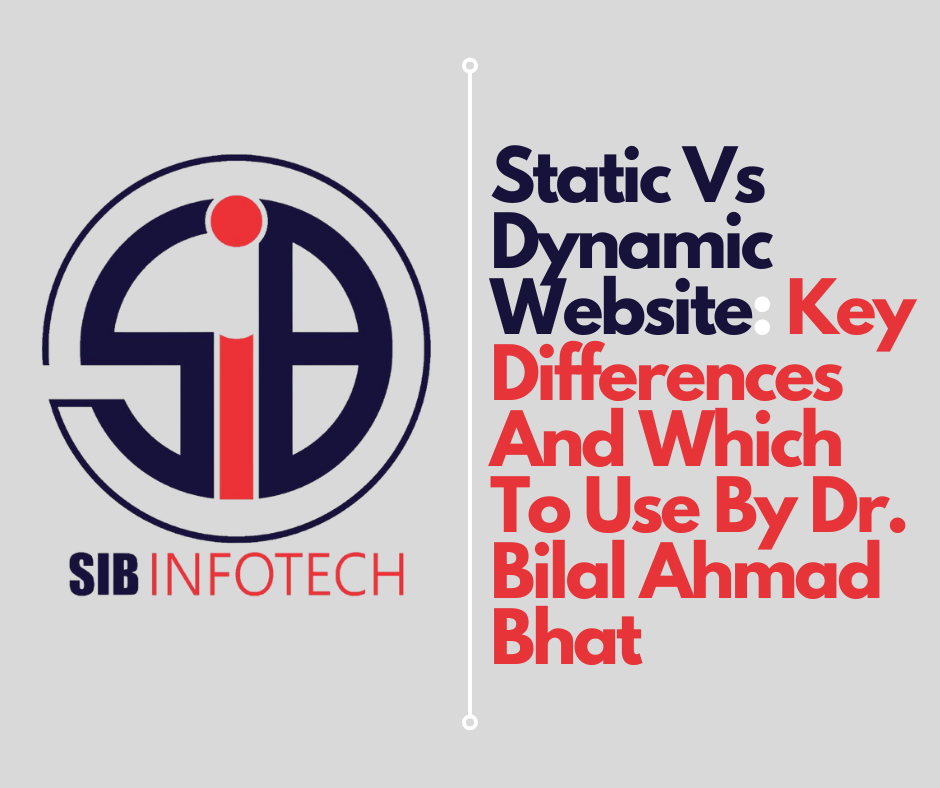Introduction
In the rapidly evolving digital landscape, the choice between static and dynamic websites is a crucial decision for businesses aiming to establish a strong online presence. This decision can significantly impact user experience, site management, and overall business growth. As we delve into the intricacies of static and dynamic websites, it’s essential to understand the key differences and their implications.
SIB Infotech: Your Web Solutions Powerhouse
At SIB Infotech, we pride ourselves on being a powerhouse of highly skilled professionals, providing state-of-the-art web solutions to our clients. Our team comprises the industry’s best website designers and programmers, dedicated to delivering exceptional results. Our commitment to client satisfaction and unparalleled after-sales support distinguishes us as the best web solution provider.
Understanding Static Websites
Static websites are built using fixed content that does not change unless manually updated by a developer. These websites are typically composed of HTML, CSS, and JavaScript, offering a straightforward and uncomplicated user experience. Static websites are:
- Simple and Fast: With fewer server requests and no database interactions, static websites load quickly, providing a seamless browsing experience.
- Cost-Effective: Development and hosting costs are relatively lower, making static websites an economical choice for small businesses or personal projects.
- Secure: With no server-side processing, the risk of security vulnerabilities is minimized.
However, static websites have limitations. They lack the interactive features and personalized content that modern users expect. Updating content can also be cumbersome, requiring technical expertise.
The Dynamic Advantage
Dynamic websites, on the other hand, offer a more flexible and interactive user experience. These websites are generated in real-time, fetching data from databases and displaying it based on user interactions. Key features of dynamic websites include:
- Interactivity: Dynamic websites can incorporate features like user logins, personalized content, and interactive forms, enhancing user engagement.
- Content Management: With Content Management Systems (CMS) like WordPress, Joomla, or Drupal, updating content becomes effortless, even for non-technical users.
- Scalability: Dynamic websites can handle large volumes of data and traffic, making them suitable for growing businesses.
However, dynamic websites require more resources for development and maintenance. They are also more susceptible to security threats due to server-side processing.
Choosing the Right Option
When deciding between a static and dynamic website, consider the following factors:
- Purpose: If your website’s primary function is to provide information without frequent updates, a static website might suffice. For e-commerce, social media, or any site requiring user interaction, a dynamic website is essential.
- Budget: Static websites are cost-effective and suitable for small businesses or personal projects with limited budgets. Dynamic websites, while more expensive, offer greater flexibility and features.
- Technical Expertise: Static websites require minimal technical skills for maintenance. Dynamic websites, especially those using a CMS, allow non-technical users to update content but may require developer support for advanced features.
- Performance: Static websites load faster due to their simplicity. However, modern dynamic websites can be optimized for performance with techniques like caching and content delivery networks (CDNs).
Urgency for Modern Businesses
In today’s competitive market, having a dynamic, interactive, and user-friendly website is more critical than ever. Static websites, while still relevant for certain applications, often fall short in meeting the demands of modern users who expect real-time updates, personalized experiences, and seamless interactivity.
Choosing the right type of website can significantly impact your business’s online success. A dynamic website not only enhances user engagement but also provides the scalability needed for growth. Investing in a dynamic website can transform your online presence, driving traffic, improving user retention, and ultimately boosting your bottom line.
Call to Action
The digital age waits for no one. As a business owner, you must act swiftly to ensure your online presence is not just adequate but exceptional. Don’t let outdated technology hinder your growth. At SIB Infotech, we are ready to guide you through the process of choosing and developing the perfect website for your needs.
Whether you need a sleek static website for simple information dissemination or a robust dynamic website for engaging user interactions, our team of experts is here to help. Contact SIB Infotech today to take the first step towards revolutionizing your online presence. Let us help you harness the power of the web to propel your business forward.
Conclusion
The debate between static and dynamic websites is not just a technical consideration but a strategic decision that can define your business’s future. By understanding the key differences and aligning your choice with your business goals, you can create a powerful online presence that meets the demands of today’s digital-savvy consumers. Embrace the dynamic revolution with SIB Infotech and watch your business thrive.

